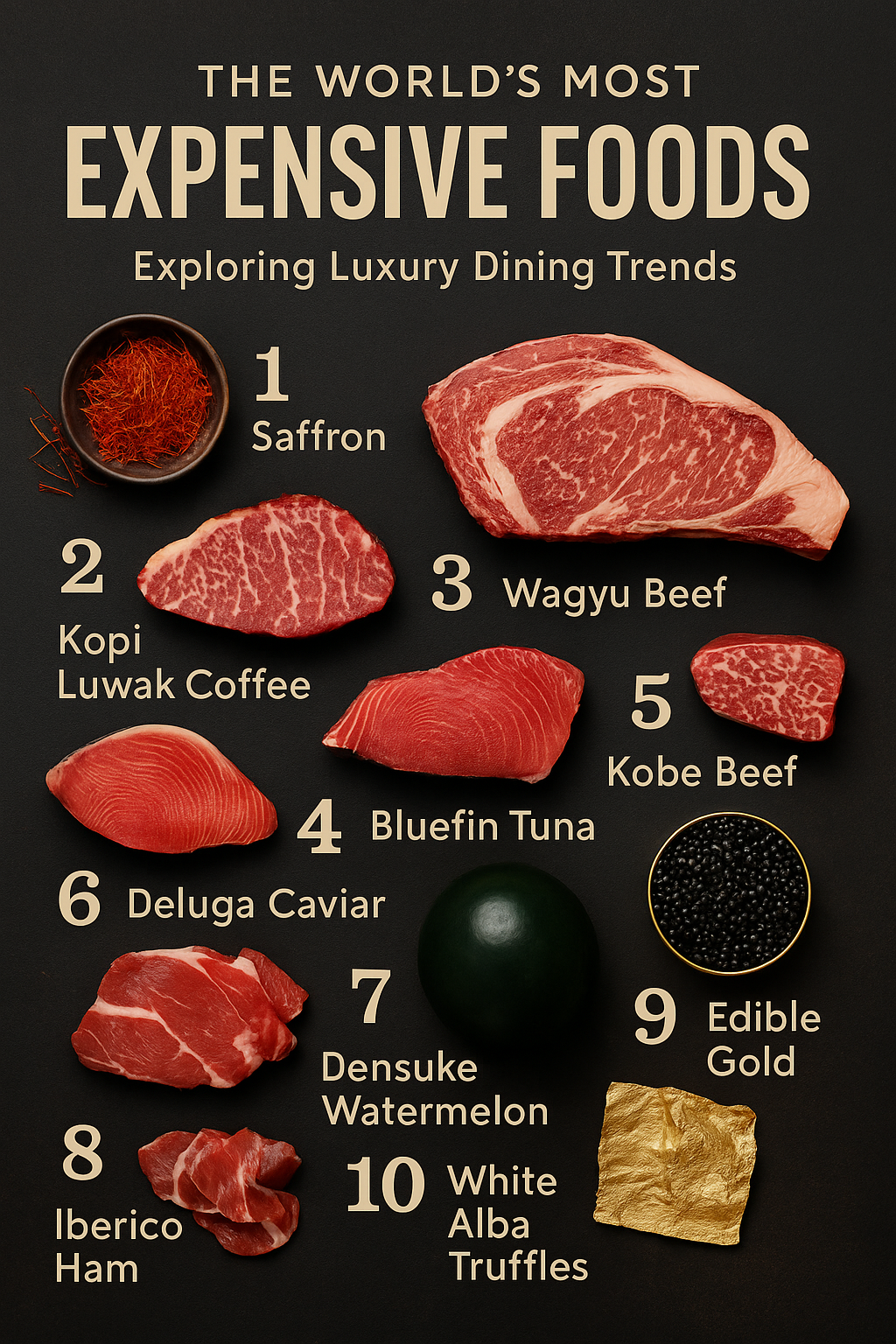In a time when people are dining out less frequently but spending more intentionally, luxury dining experiences are on the rise. Today’s guests are trading quantity for quality — treating every meal as a special occasion. Whether you’re dreaming of how the world’s elite dine or looking for creative menu inspiration, exploring the world’s most expensive foods reveals insights into flavor, exclusivity, and innovation.
At Hospitality Connect, we believe chefs and restaurateurs can take inspiration from global luxury ingredients to elevate everyday menus. From saffron and Wagyu beef to truffles and caviar, this guide explores the rare ingredients that define fine dining — and how you can capture their essence without exceeding your budget.
Why Luxury Ingredients Matter
In professional kitchens, luxury ingredients are about more than cost — they’re about craftsmanship, culture, and story. Each rare product carries a history of meticulous farming, harvesting, and refinement. Using them (or inspired alternatives) helps chefs craft memorable experiences that justify premium pricing and strengthen brand identity.
For further reading on culinary trends and ingredient sourcing, explore Food Standards Australia New Zealand (FSANZ) and The Culinary Institute of America
🌸 1. Saffron — The Golden Spice of the World
Harvested from the Crocus sativus flower, saffron is the world’s most expensive spice, costing between $5–$20 per gram. Its rich aroma and golden color elevate dishes like risotto, bouillabaisse, and Persian desserts.
Affordable Alternative: Try turmeric or marigold petals for similar color and a warm, earthy flavor.
🥩 2. Wagyu Beef — The Ultimate in Buttery Perfection
Japan’s Wagyu beef is renowned for its intricate marbling and tenderness. With prices reaching $150 per pound, it’s the benchmark of indulgence in steak and sushi dishes.
Affordable Alternative: Australian Wagyu or premium ribeye can provide comparable flavor and texture.
☕ 3. Kopi Luwak Coffee — The World’s Most Exclusive Brew
Sourced from beans naturally fermented by the Asian palm civet, Kopi Luwak coffee can exceed $300 per pound. The process creates a silky, low-acid coffee with caramel undertones.
Affordable Alternative: Jamaican Blue Mountain or Ethiopian Yirgacheffe coffee offer exquisite flavor at a lower cost.
🐟 4. Bluefin Tuna — Oceanic Luxury
A staple of high-end Japanese cuisine, Bluefin tuna sells for $200–$400 per pound. Its rich, buttery texture makes it prized for sashimi and sushi.
Affordable Alternative: Yellowfin or albacore tuna deliver similar freshness and taste.
🐮 5. Kobe Beef — Japan’s Culinary Crown Jewel
A rarer subset of Wagyu, Kobe beef is strictly regulated and highly sought-after, commanding $200–$500 per pound. Its balance of sweetness and fat makes it a top-tier delicacy.
Affordable Alternative: USDA Prime or Australian Wagyu provide satisfying luxury without the price tag.
🐟 6. Beluga Caviar — The Taste of True Elegance
Extracted from Beluga sturgeon, this caviar can cost up to $300 per ounce. Its creamy texture and nutty aftertaste embody refinement.
Affordable Alternative: Paddlefish caviar or salmon roe deliver comparable elegance at a lower price point.
🍉 7. Densuke Watermelon — Japan’s Sweet Black Gem
With its glossy black rind and honey-sweet interior, the Densuke watermelon from Hokkaido can sell for $250 each. Grown in limited quantities, it’s a collector’s fruit.
Affordable Alternative: Try Crimson Sweet or Sugar Baby watermelons for similar sweetness and presentation.
🍖 8. Iberico Ham — Spain’s Finest Delicacy
Spain’s Jamón Ibérico comes from acorn-fed Iberian pigs and costs around $80–$110 per pound. Its melt-in-your-mouth texture and nutty flavor define European charcuterie.
Affordable Alternative: Serrano ham or prosciutto are excellent, more accessible substitutes.
✨ 9. Edible Gold — The Art of Luxury Plating
Used to decorate desserts and cocktails, edible gold leaf is priced at $2.50 per sheet. Though flavorless, it adds unmatched glamour and sophistication to plating.
Affordable Alternative: Edible silver leaf or pearl dust provide sparkle with less expense.
🍄 10. White Alba Truffles — The Diamond of the Kitchen
Found only in Italy’s Piedmont region, White Alba truffles can exceed $300 per ounce. Their intoxicating aroma enhances pasta, risotto, and eggs with earthy luxury.
Affordable Alternative: Use truffle oil, truffle salt, or black truffles for a similar sensory experience.
Tools for Precision and Presentation
At Hospitality Connect, we know that even the finest ingredients deserve precision tools. Explore our range of professional-grade kitchen equipment designed for performance, consistency, and presentation — from chef knives and utensils to serving ware and bar accessories that elevate the luxury dining experience.
Equip your kitchen with premium tools trusted by Australian hospitality professionals.
👉 Explore Hospitality Connect’s Premium Equipment Range
Expert Tips for Creating Luxury Dining Experiences
-
Focus on presentation: Use fine tableware, lighting, and plating to communicate value.
-
Tell ingredient stories: Educate diners about origins and craftsmanship to enhance perceived worth.
-
Blend premium with practical: Combine luxury highlights with locally sourced produce to manage cost.
-
Train for precision: Ensure kitchen teams maintain consistency in plating and portioning.
-
Incorporate sensory appeal: Pair flavors with textures, aromas, and visuals for a multisensory experience.
FAQs: Luxury Dining and Ingredient Substitutions
What makes an ingredient “luxury”?
Rarity, craftsmanship, and exclusivity. Ingredients like truffles or Wagyu require specific climates, care, and time.
Can I make fine dining affordable?
Yes. Focus on creativity, presentation, and quality substitutes — not just cost.
Where can I source premium culinary tools in Australia?
Visit Hospitality Connect for Australian-standard hospitality equipment, including utensils, kitchenware, and bar tools trusted by professionals nationwide.
Conclusion: Elevate Your Menu, Inspire Your Guests
Luxury dining isn’t just about indulgence — it’s about experience, precision, and passion. By learning from the world’s most expensive ingredients and using professional tools, chefs can transform any dish into a statement of excellence.
At Hospitality Connect, we’re proud to support Australia’s culinary professionals with high-quality commercial kitchen equipment, barware, and fine dining essentials that empower creativity and performance.
For more culinary insights, visit Hospitality Connect — your trusted partner in professional kitchen solutions.
🔗 External References
External References: Food Standards Australia New Zealand | The Culinary Institute of Australia










